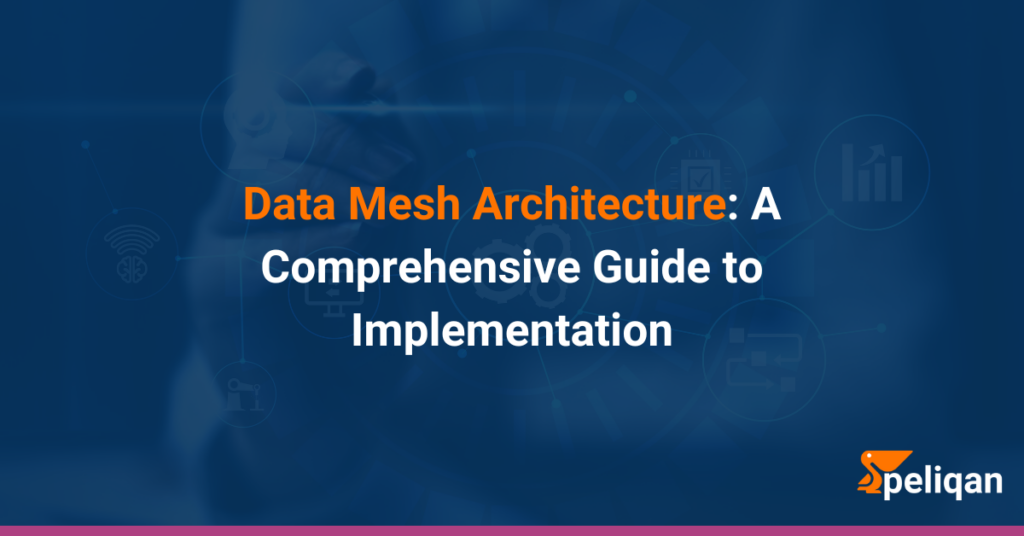Let’s dive deeper into each of these pillars and see how they contribute to the overall data mesh architecture:
These pillars work together to create a flexible, scalable, and efficient data architecture that can adapt to the evolving needs of modern businesses.
The Evolution of Data Architecture: From Monolithic to Mesh
To truly appreciate the value of data mesh architecture, it’s essential to understand how it evolved from previous data management approaches. Let’s take a brief journey through the history of data architecture:
- Monolithic Data Warehouses: Traditional centralized repositories that struggled with scalability and agility.
- Data Lakes: Centralized stores for all types of data, which often became unwieldy “data swamps.”
- Data Fabric: An architecture that focuses on data integration across distributed environments.
- Data Mesh: A decentralized approach that treats data as a product and pushes ownership to domain experts.
Data mesh architecture addresses many of the limitations of its predecessors, offering a more flexible and scalable approach to data management in complex, distributed environments.
Implementing Data Mesh Architecture: A Step-by-Step Guide
Now that we understand the principles of data mesh architecture, let’s explore how Peliqan’s comprehensive platform aligns with these principles and facilitates implementation. We’ll break this down into steps corresponding to the four pillars:
1. Domain-Oriented Data Ownership
Peliqan empowers domain teams to take ownership of their data by providing:
- Flexible Data Ingestion: Peliqan offers pre-built connectors for various data sources, allowing domain teams to easily ingest data from their specific systems.
- Domain-Specific Data Modeling: Teams can create custom data models that reflect their domain’s unique needs and terminologies.
For example, a marketing team can use Peliqan to ingest data from their CRM, marketing automation tools, and web analytics platforms, creating a comprehensive view of customer interactions within their domain.
2. Data as a Product
Peliqan facilitates the “data as a product” approach through:
- Semantic Layer: Define business-friendly metrics and dimensions that can be easily consumed by other teams.
- Data Quality Monitoring: Set up automated quality checks to ensure the reliability of your data products.
- Version Control: Track changes to your data products over time, enabling rollbacks if needed.
For instance, the finance domain can create a “Monthly Revenue” metric in Peliqan’s semantic layer, making it available for other teams to use in their analyses without needing to understand the underlying data structure.
3. Self-Serve Data Infrastructure
Peliqan provides a robust self-serve platform:
- Visual Pipeline Builder: Create and manage data pipelines without extensive coding knowledge.
- Automated Data Discovery: Easily find and explore available data products across domains.
- API Access: Expose data products via REST APIs for easy consumption by applications and BI tools.
This allows teams like sales to use Peliqan’s visual interface to build pipelines that combine data from their CRM with finance team’s revenue data, creating comprehensive sales performance dashboards.
4. Federated Computational Governance
Peliqan supports federated governance through:
- Centralized Policy Management: Define and enforce data access policies across all domains.
- Data Lineage Tracking: Automatically track data lineage to ensure compliance and auditability.
- Metadata Management: Maintain a centralized repository of metadata for all data products.
For example, the data governance team can use Peliqan to set up organization-wide policies for data classification and access control, which are then automatically applied to all data products across domains.
Data Mesh Architecture in Action: Real-World Scenarios
Let’s explore how Peliqan enables data mesh architecture in various real-world scenarios:
Scenario 1: Data to BI
In a data mesh architecture, getting the right data into your BI tools can be challenging due to the distributed nature of data ownership. Peliqan simplifies this process:
- Data Discovery: BI teams can use Peliqan’s data catalog to discover relevant data products across domains.
- Semantic Layer: Peliqan’s semantic layer allows domains to expose their data in business-friendly terms, making it easier for BI teams to understand and use the data.
- Data Federation: Peliqan can federate queries across multiple data products, allowing BI tools to access data from various domains seamlessly.
Scenario 2: Data to Data Warehouse
In a data mesh, the central data warehouse evolves into a federated system of domain-specific data products. Peliqan facilitates this transition:
- Decentralized ETL: Domain teams use Peliqan to create their own ETL pipelines, loading data into their specific areas of the data warehouse.
- Data Product Registry: Peliqan maintains a registry of all data products, making it easy for other domains to discover and use relevant data.
- Automated Schema Evolution: As domain data models evolve, Peliqan can automatically update the corresponding data warehouse schemas.
Scenario 3: Data to Machine Learning
Data mesh can significantly improve the efficiency of machine learning workflows. Here’s how Peliqan supports this:
- Feature Store: Peliqan can act as a centralized feature store, where domains publish reusable features for ML models.
- Data Versioning: Track different versions of datasets used for model training, ensuring reproducibility.
- Model Serving: Deploy trained models as data products, making them available for real-time inference across the organization.
Overcoming Data Mesh Architecture Challenges with Peliqan
While data mesh architecture offers numerous benefits, it also presents significant challenges. Here’s how Peliqan addresses the key hurdles:
Interoperability:
Peliqan employs intelligent query federation and adaptive caching to optimize performance when querying across distributed data products. The platform’s query engine analyzes and optimizes complex queries to ensure efficient execution across the data mesh. Peliqan also implements automatic caching of frequently accessed data, improving response times for common requests and enhancing overall system performance.
By addressing these challenges, Peliqan enables organizations to overcome common obstacles in implementing data mesh architecture and realize its full potential.
The Future of Data Mesh Architecture: Trends and Predictions
As data mesh architecture continues to evolve, several trends are emerging:
- AI-Driven Data Mesh: AI will play a crucial role in automating data product creation, enhancing data quality management, and providing intelligent governance recommendations. Peliqan is integrating advanced AI capabilities to support these functions.
- Edge Computing Integration: Data mesh principles will extend to edge devices for real-time processing. Peliqan is developing edge-specific connectors and lightweight runtimes to support this trend.
- Cross-Organizational Data Mesh: Organizations will implement data mesh across multiple entities for enhanced collaboration. Peliqan is working on features to facilitate secure cross-organizational data sharing and collaborative governance.
- Enhanced Observability: Comprehensive monitoring and lineage tracking across the entire mesh will become critical. Peliqan is enhancing its observability features, including advanced data lineage visualization and real-time mesh monitoring.
As these trends shape the future of data mesh architecture,
Peliqan remains committed to innovation, continuously evolving its platform to meet the changing needs of organizations implementing data mesh.
Conclusion: Embracing Data Mesh Architecture with Peliqan
Data mesh architecture represents a paradigm shift in how organizations manage and utilize their data assets. By aligning closely with the principles of data mesh, Peliqan provides a comprehensive platform that simplifies the implementation of this powerful architecture.
From empowering domain-oriented data ownership to facilitating self-serve infrastructure and federated governance, Peliqan offers the tools and capabilities needed to transform your organization’s data landscape. Whether you’re feeding data into BI tools, populating a data warehouse, or building machine learning models, Peliqan’s data mesh approach ensures that you can do so efficiently and effectively
As you embark on your data mesh architecture journey, remember that the transition is as much about organizational change as it is about technology. Start small, focus on high-value use cases, and leverage Peliqan’s capabilities to gradually build out your data mesh architecture. With persistence and the right tools, you can unlock the full potential of your organization’s data, driving innovation and informed decision-making across all domains.
Are you ready to revolutionize your data architecture with data mesh? Explore how Peliqan can guide you through this transformative journey, turning your data challenges into opportunities for growth and innovation.
FAQ’s
1. What is the data mesh architecture?
Data mesh architecture is a decentralized approach to data management that treats data as a product, distributes data ownership to domain experts, and provides a self-serve data infrastructure platform. It aims to overcome the scalability and agility challenges of traditional centralized data architectures.
2. What are the 4 pillars of data mesh?
The four pillars of data mesh are:
- Domain-oriented, decentralized data ownership and architecture
- Data as a product
- Self-serve data infrastructure as a platform
- Federated computational governance
3. What is a data mesh vs data lake?
While both data mesh and data lake are approaches to managing large volumes of data, they differ significantly:
- Data Lake: A centralized repository that stores all types of data (structured, semi-structured, and unstructured) in its raw form. It’s managed by a central team and often struggles with scalability and agility in large organizations.
- Data Mesh: A decentralized approach where data is managed by domain teams as products. It aims to improve scalability, agility, and data quality by pushing data ownership to those who understand it best.
4. What is mesh in architecture?
In the context of data architecture, “mesh” refers to a network of interconnected data products. Each data product is independently managed by a domain team but can be easily discovered and consumed by other domains. This mesh of data products allows for more flexible and scalable data management compared to traditional centralized architectures.

